Project Execution Planning and Management: A Comparative Study
VerifiedAdded on 2020/03/02
|13
|3053
|42
Project
AI Summary
This project analyzes project execution planning and management, focusing on project delivery systems, financial contract types, and procurement methods. It examines Design-Bid-Build, Design-Build, and CM @ Risk delivery systems, evaluating them based on criteria like delivery schedule, complexity, risk assessment, and cost. The analysis reveals Design-Build as the most suitable method for a large, 7-year project due to its efficiency and cost-effectiveness. The project also explores financial contract types, including lump sum, guaranteed maximum price, and cost-plus fixed fee, recommending the lump sum contract for its benefits. Furthermore, it discusses competitive, negotiated, and best value procurement methods, emphasizing the importance of fair bidding and contractor expertise. The evaluation matrices provide a clear comparison, supporting the recommendations with weighted scores and detailed criteria analysis.
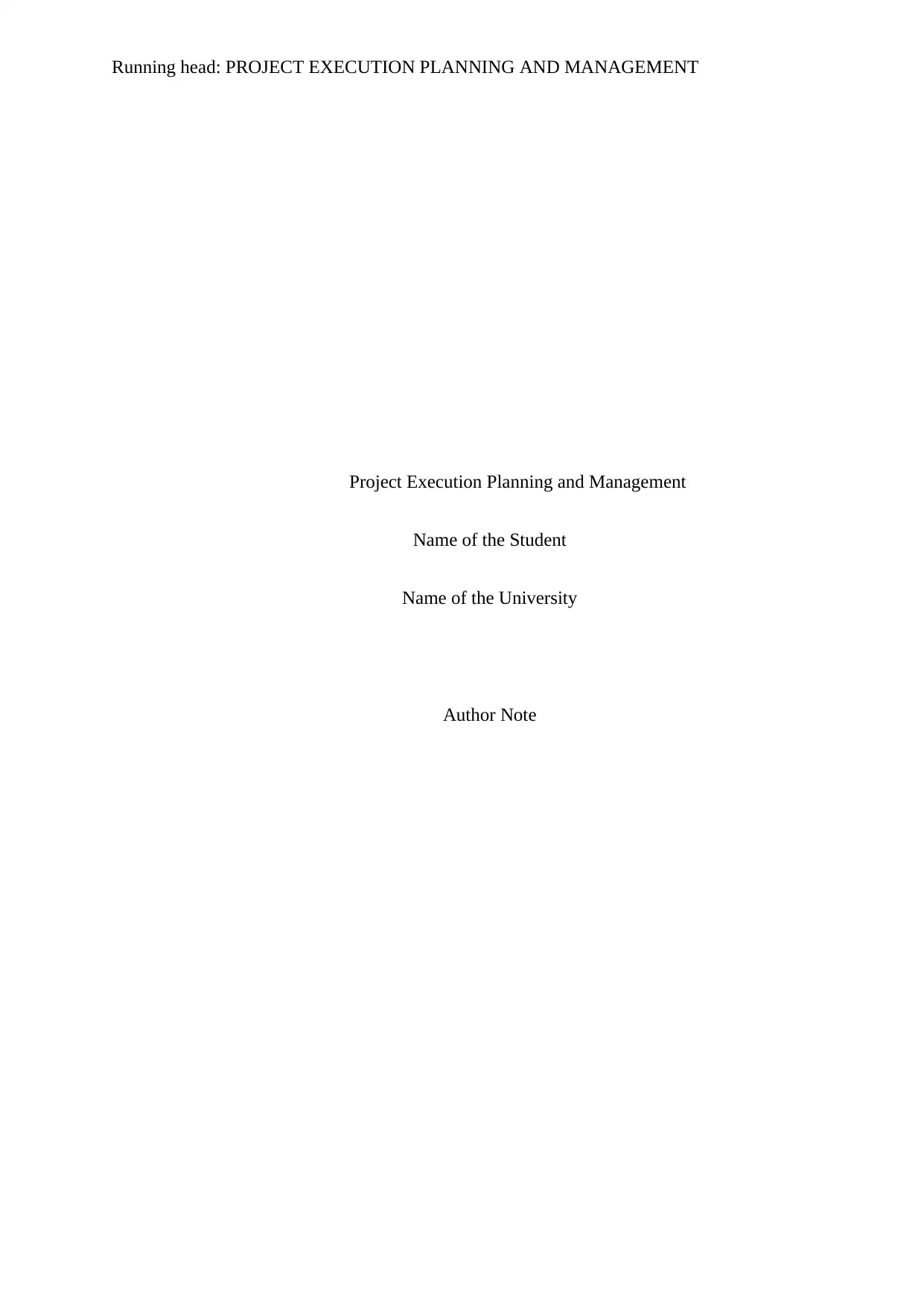
Running head: PROJECT EXECUTION PLANNING AND MANAGEMENT
Project Execution Planning and Management
Name of the Student
Name of the University
Author Note
Project Execution Planning and Management
Name of the Student
Name of the University
Author Note
Paraphrase This Document
Need a fresh take? Get an instant paraphrase of this document with our AI Paraphraser
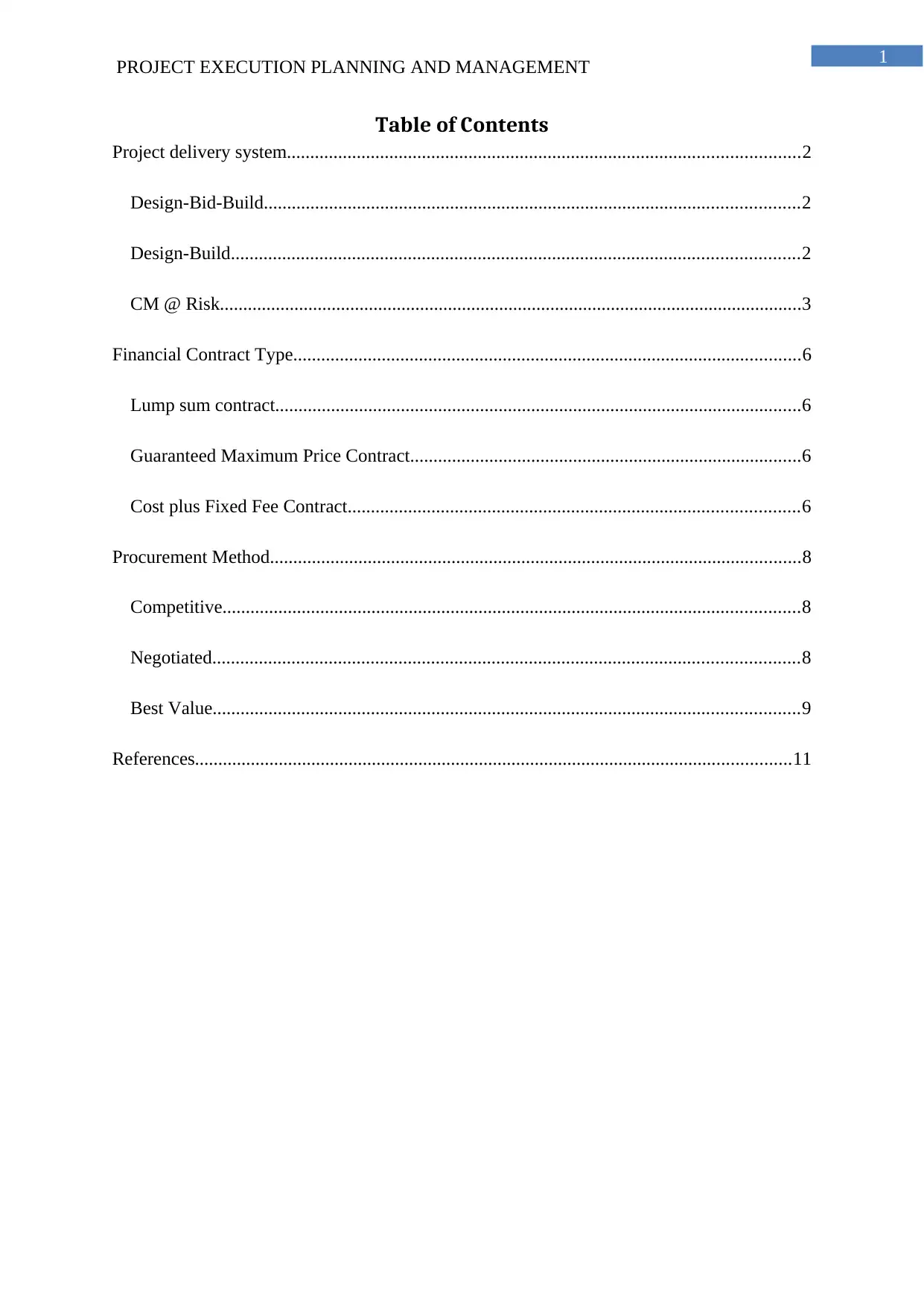
1
PROJECT EXECUTION PLANNING AND MANAGEMENT
Table of Contents
Project delivery system..............................................................................................................2
Design-Bid-Build...................................................................................................................2
Design-Build..........................................................................................................................2
CM @ Risk.............................................................................................................................3
Financial Contract Type.............................................................................................................6
Lump sum contract.................................................................................................................6
Guaranteed Maximum Price Contract....................................................................................6
Cost plus Fixed Fee Contract.................................................................................................6
Procurement Method..................................................................................................................8
Competitive............................................................................................................................8
Negotiated..............................................................................................................................8
Best Value..............................................................................................................................9
References................................................................................................................................11
PROJECT EXECUTION PLANNING AND MANAGEMENT
Table of Contents
Project delivery system..............................................................................................................2
Design-Bid-Build...................................................................................................................2
Design-Build..........................................................................................................................2
CM @ Risk.............................................................................................................................3
Financial Contract Type.............................................................................................................6
Lump sum contract.................................................................................................................6
Guaranteed Maximum Price Contract....................................................................................6
Cost plus Fixed Fee Contract.................................................................................................6
Procurement Method..................................................................................................................8
Competitive............................................................................................................................8
Negotiated..............................................................................................................................8
Best Value..............................................................................................................................9
References................................................................................................................................11
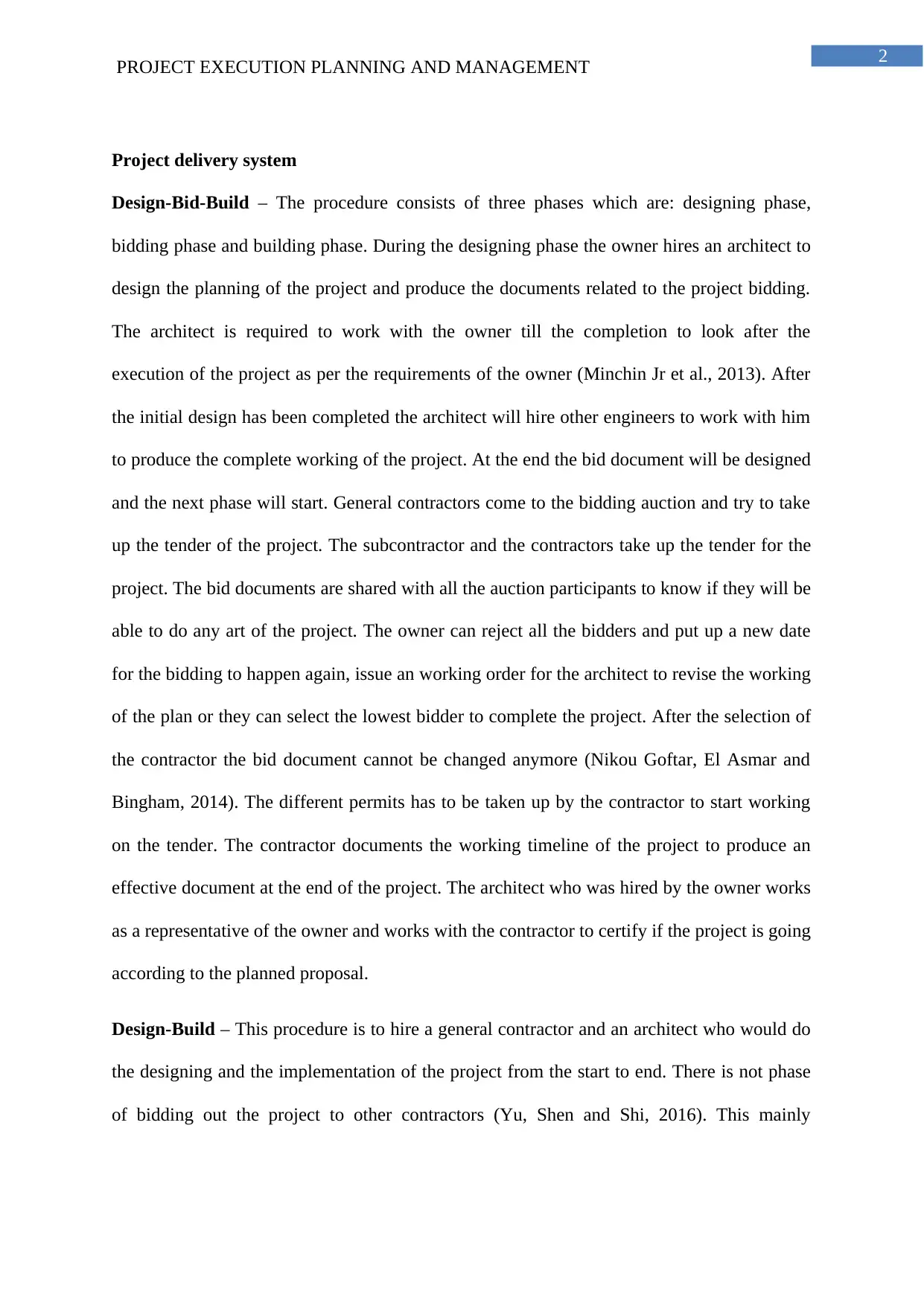
2
PROJECT EXECUTION PLANNING AND MANAGEMENT
Project delivery system
Design-Bid-Build – The procedure consists of three phases which are: designing phase,
bidding phase and building phase. During the designing phase the owner hires an architect to
design the planning of the project and produce the documents related to the project bidding.
The architect is required to work with the owner till the completion to look after the
execution of the project as per the requirements of the owner (Minchin Jr et al., 2013). After
the initial design has been completed the architect will hire other engineers to work with him
to produce the complete working of the project. At the end the bid document will be designed
and the next phase will start. General contractors come to the bidding auction and try to take
up the tender of the project. The subcontractor and the contractors take up the tender for the
project. The bid documents are shared with all the auction participants to know if they will be
able to do any art of the project. The owner can reject all the bidders and put up a new date
for the bidding to happen again, issue an working order for the architect to revise the working
of the plan or they can select the lowest bidder to complete the project. After the selection of
the contractor the bid document cannot be changed anymore (Nikou Goftar, El Asmar and
Bingham, 2014). The different permits has to be taken up by the contractor to start working
on the tender. The contractor documents the working timeline of the project to produce an
effective document at the end of the project. The architect who was hired by the owner works
as a representative of the owner and works with the contractor to certify if the project is going
according to the planned proposal.
Design-Build – This procedure is to hire a general contractor and an architect who would do
the designing and the implementation of the project from the start to end. There is not phase
of bidding out the project to other contractors (Yu, Shen and Shi, 2016). This mainly
PROJECT EXECUTION PLANNING AND MANAGEMENT
Project delivery system
Design-Bid-Build – The procedure consists of three phases which are: designing phase,
bidding phase and building phase. During the designing phase the owner hires an architect to
design the planning of the project and produce the documents related to the project bidding.
The architect is required to work with the owner till the completion to look after the
execution of the project as per the requirements of the owner (Minchin Jr et al., 2013). After
the initial design has been completed the architect will hire other engineers to work with him
to produce the complete working of the project. At the end the bid document will be designed
and the next phase will start. General contractors come to the bidding auction and try to take
up the tender of the project. The subcontractor and the contractors take up the tender for the
project. The bid documents are shared with all the auction participants to know if they will be
able to do any art of the project. The owner can reject all the bidders and put up a new date
for the bidding to happen again, issue an working order for the architect to revise the working
of the plan or they can select the lowest bidder to complete the project. After the selection of
the contractor the bid document cannot be changed anymore (Nikou Goftar, El Asmar and
Bingham, 2014). The different permits has to be taken up by the contractor to start working
on the tender. The contractor documents the working timeline of the project to produce an
effective document at the end of the project. The architect who was hired by the owner works
as a representative of the owner and works with the contractor to certify if the project is going
according to the planned proposal.
Design-Build – This procedure is to hire a general contractor and an architect who would do
the designing and the implementation of the project from the start to end. There is not phase
of bidding out the project to other contractors (Yu, Shen and Shi, 2016). This mainly
⊘ This is a preview!⊘
Do you want full access?
Subscribe today to unlock all pages.

Trusted by 1+ million students worldwide
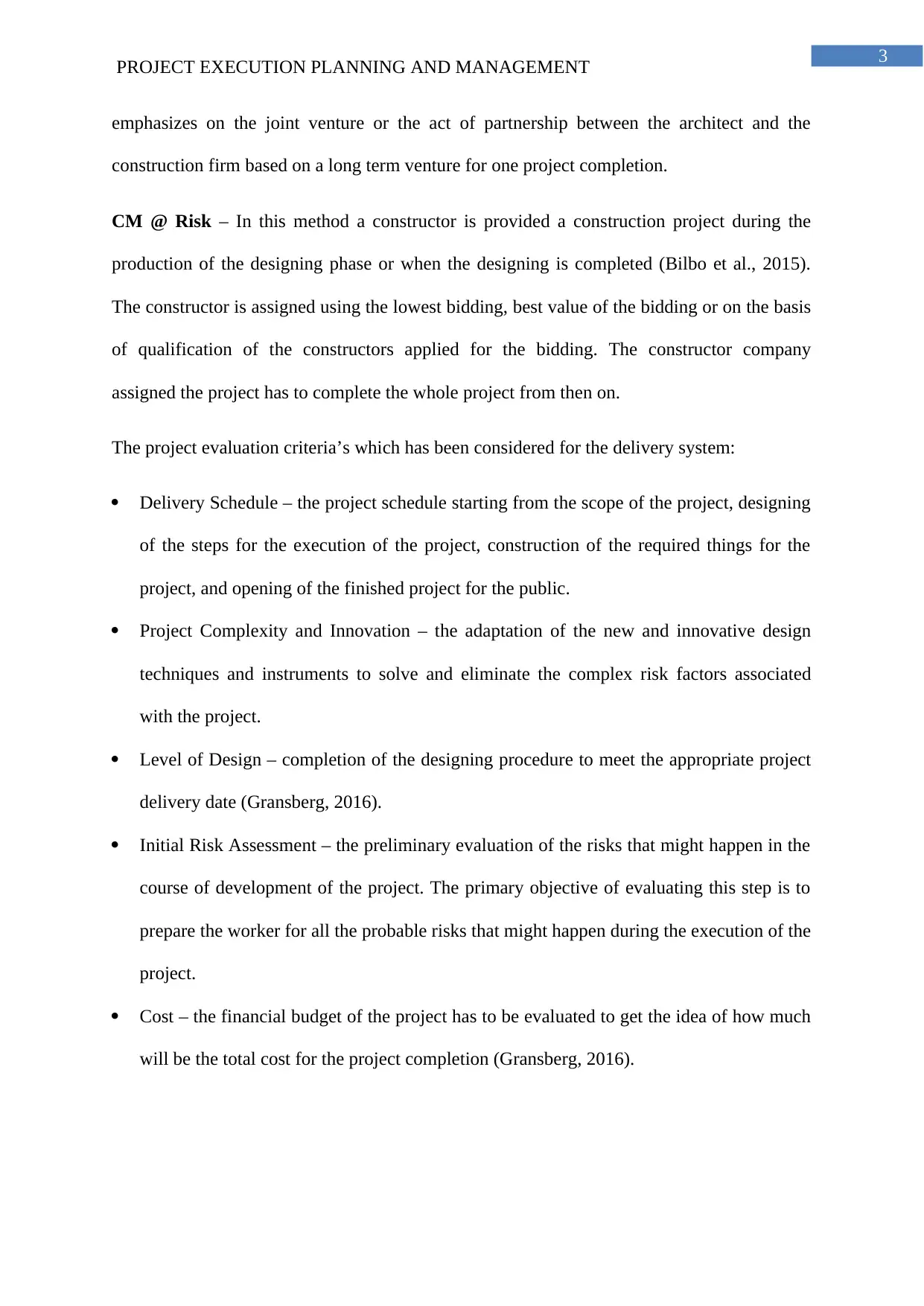
3
PROJECT EXECUTION PLANNING AND MANAGEMENT
emphasizes on the joint venture or the act of partnership between the architect and the
construction firm based on a long term venture for one project completion.
CM @ Risk – In this method a constructor is provided a construction project during the
production of the designing phase or when the designing is completed (Bilbo et al., 2015).
The constructor is assigned using the lowest bidding, best value of the bidding or on the basis
of qualification of the constructors applied for the bidding. The constructor company
assigned the project has to complete the whole project from then on.
The project evaluation criteria’s which has been considered for the delivery system:
Delivery Schedule – the project schedule starting from the scope of the project, designing
of the steps for the execution of the project, construction of the required things for the
project, and opening of the finished project for the public.
Project Complexity and Innovation – the adaptation of the new and innovative design
techniques and instruments to solve and eliminate the complex risk factors associated
with the project.
Level of Design – completion of the designing procedure to meet the appropriate project
delivery date (Gransberg, 2016).
Initial Risk Assessment – the preliminary evaluation of the risks that might happen in the
course of development of the project. The primary objective of evaluating this step is to
prepare the worker for all the probable risks that might happen during the execution of the
project.
Cost – the financial budget of the project has to be evaluated to get the idea of how much
will be the total cost for the project completion (Gransberg, 2016).
PROJECT EXECUTION PLANNING AND MANAGEMENT
emphasizes on the joint venture or the act of partnership between the architect and the
construction firm based on a long term venture for one project completion.
CM @ Risk – In this method a constructor is provided a construction project during the
production of the designing phase or when the designing is completed (Bilbo et al., 2015).
The constructor is assigned using the lowest bidding, best value of the bidding or on the basis
of qualification of the constructors applied for the bidding. The constructor company
assigned the project has to complete the whole project from then on.
The project evaluation criteria’s which has been considered for the delivery system:
Delivery Schedule – the project schedule starting from the scope of the project, designing
of the steps for the execution of the project, construction of the required things for the
project, and opening of the finished project for the public.
Project Complexity and Innovation – the adaptation of the new and innovative design
techniques and instruments to solve and eliminate the complex risk factors associated
with the project.
Level of Design – completion of the designing procedure to meet the appropriate project
delivery date (Gransberg, 2016).
Initial Risk Assessment – the preliminary evaluation of the risks that might happen in the
course of development of the project. The primary objective of evaluating this step is to
prepare the worker for all the probable risks that might happen during the execution of the
project.
Cost – the financial budget of the project has to be evaluated to get the idea of how much
will be the total cost for the project completion (Gransberg, 2016).
Paraphrase This Document
Need a fresh take? Get an instant paraphrase of this document with our AI Paraphraser
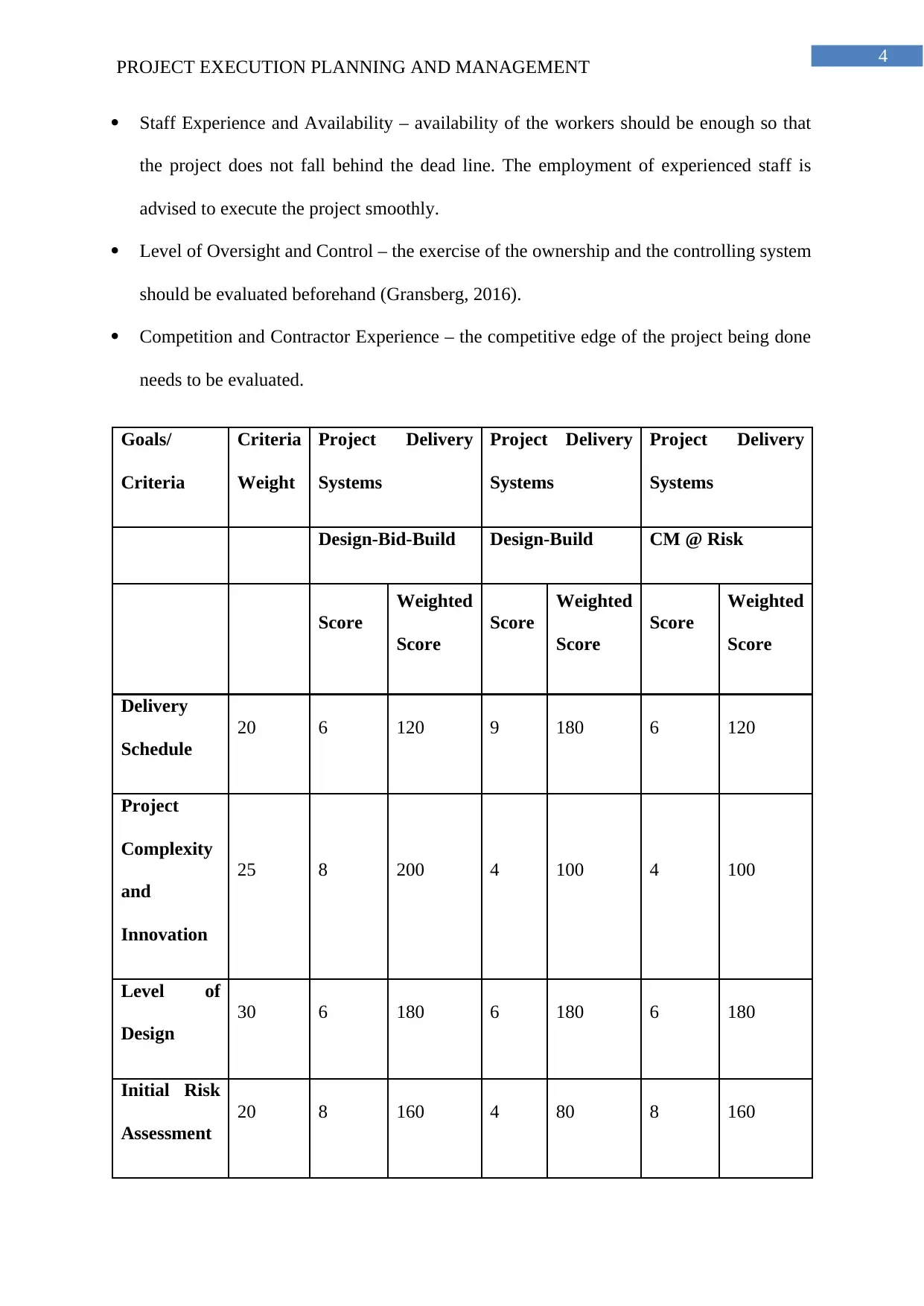
4
PROJECT EXECUTION PLANNING AND MANAGEMENT
Staff Experience and Availability – availability of the workers should be enough so that
the project does not fall behind the dead line. The employment of experienced staff is
advised to execute the project smoothly.
Level of Oversight and Control – the exercise of the ownership and the controlling system
should be evaluated beforehand (Gransberg, 2016).
Competition and Contractor Experience – the competitive edge of the project being done
needs to be evaluated.
Goals/
Criteria
Criteria
Weight
Project Delivery
Systems
Project Delivery
Systems
Project Delivery
Systems
Design-Bid-Build Design-Build CM @ Risk
Score
Weighted
Score
Score
Weighted
Score
Score
Weighted
Score
Delivery
Schedule
20 6 120 9 180 6 120
Project
Complexity
and
Innovation
25 8 200 4 100 4 100
Level of
Design
30 6 180 6 180 6 180
Initial Risk
Assessment
20 8 160 4 80 8 160
PROJECT EXECUTION PLANNING AND MANAGEMENT
Staff Experience and Availability – availability of the workers should be enough so that
the project does not fall behind the dead line. The employment of experienced staff is
advised to execute the project smoothly.
Level of Oversight and Control – the exercise of the ownership and the controlling system
should be evaluated beforehand (Gransberg, 2016).
Competition and Contractor Experience – the competitive edge of the project being done
needs to be evaluated.
Goals/
Criteria
Criteria
Weight
Project Delivery
Systems
Project Delivery
Systems
Project Delivery
Systems
Design-Bid-Build Design-Build CM @ Risk
Score
Weighted
Score
Score
Weighted
Score
Score
Weighted
Score
Delivery
Schedule
20 6 120 9 180 6 120
Project
Complexity
and
Innovation
25 8 200 4 100 4 100
Level of
Design
30 6 180 6 180 6 180
Initial Risk
Assessment
20 8 160 4 80 8 160
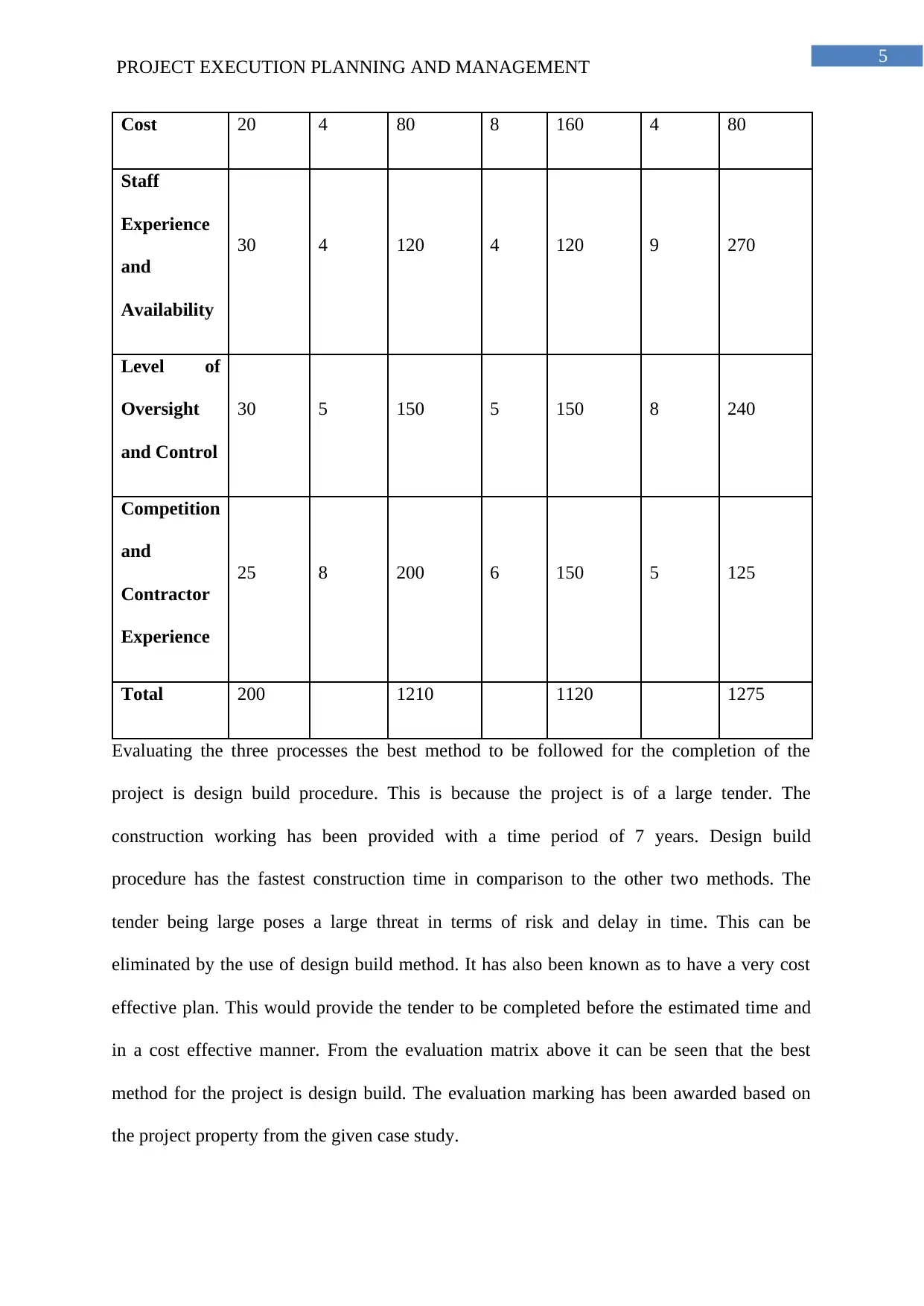
5
PROJECT EXECUTION PLANNING AND MANAGEMENT
Cost 20 4 80 8 160 4 80
Staff
Experience
and
Availability
30 4 120 4 120 9 270
Level of
Oversight
and Control
30 5 150 5 150 8 240
Competition
and
Contractor
Experience
25 8 200 6 150 5 125
Total 200 1210 1120 1275
Evaluating the three processes the best method to be followed for the completion of the
project is design build procedure. This is because the project is of a large tender. The
construction working has been provided with a time period of 7 years. Design build
procedure has the fastest construction time in comparison to the other two methods. The
tender being large poses a large threat in terms of risk and delay in time. This can be
eliminated by the use of design build method. It has also been known as to have a very cost
effective plan. This would provide the tender to be completed before the estimated time and
in a cost effective manner. From the evaluation matrix above it can be seen that the best
method for the project is design build. The evaluation marking has been awarded based on
the project property from the given case study.
PROJECT EXECUTION PLANNING AND MANAGEMENT
Cost 20 4 80 8 160 4 80
Staff
Experience
and
Availability
30 4 120 4 120 9 270
Level of
Oversight
and Control
30 5 150 5 150 8 240
Competition
and
Contractor
Experience
25 8 200 6 150 5 125
Total 200 1210 1120 1275
Evaluating the three processes the best method to be followed for the completion of the
project is design build procedure. This is because the project is of a large tender. The
construction working has been provided with a time period of 7 years. Design build
procedure has the fastest construction time in comparison to the other two methods. The
tender being large poses a large threat in terms of risk and delay in time. This can be
eliminated by the use of design build method. It has also been known as to have a very cost
effective plan. This would provide the tender to be completed before the estimated time and
in a cost effective manner. From the evaluation matrix above it can be seen that the best
method for the project is design build. The evaluation marking has been awarded based on
the project property from the given case study.
⊘ This is a preview!⊘
Do you want full access?
Subscribe today to unlock all pages.

Trusted by 1+ million students worldwide
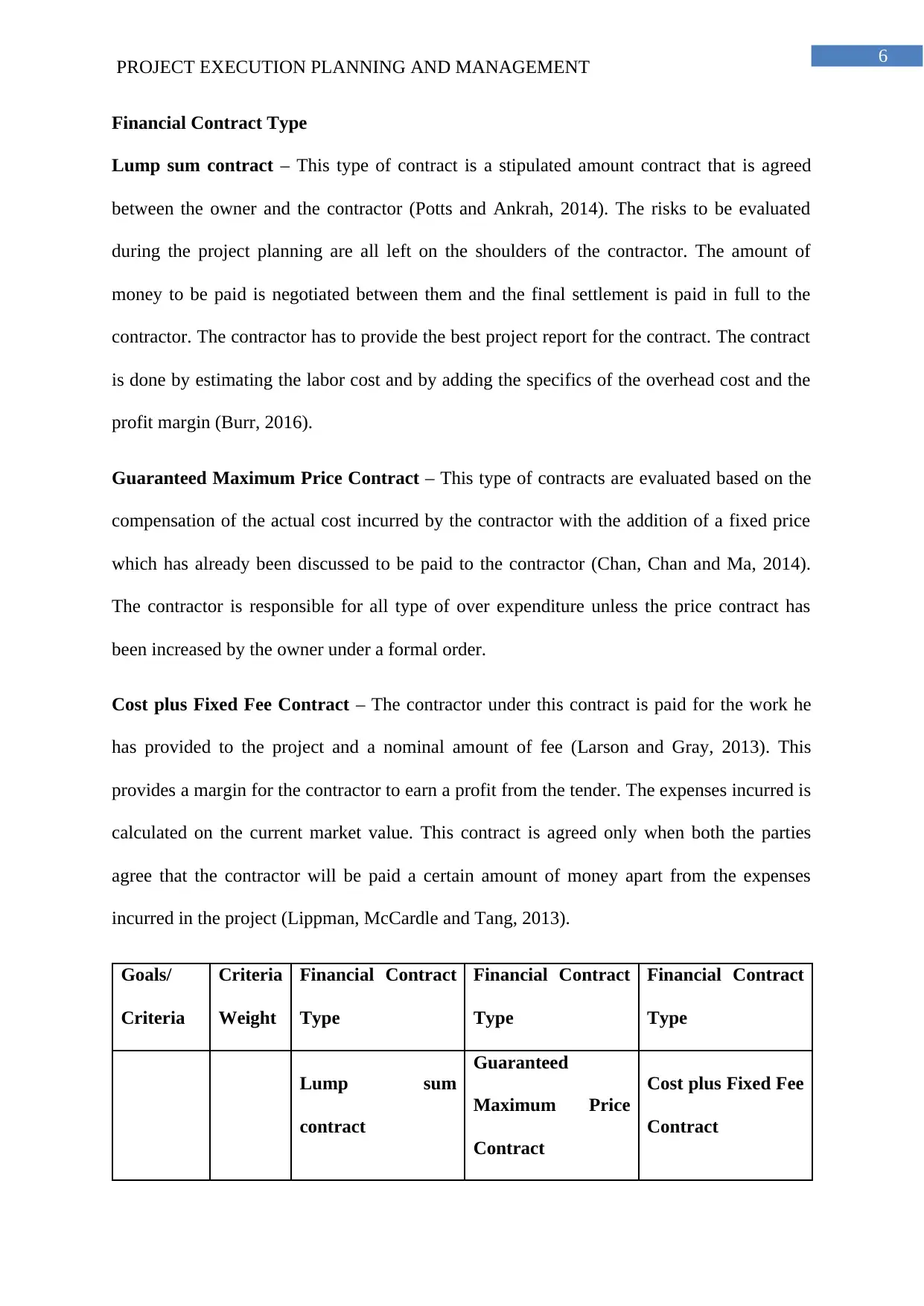
6
PROJECT EXECUTION PLANNING AND MANAGEMENT
Financial Contract Type
Lump sum contract – This type of contract is a stipulated amount contract that is agreed
between the owner and the contractor (Potts and Ankrah, 2014). The risks to be evaluated
during the project planning are all left on the shoulders of the contractor. The amount of
money to be paid is negotiated between them and the final settlement is paid in full to the
contractor. The contractor has to provide the best project report for the contract. The contract
is done by estimating the labor cost and by adding the specifics of the overhead cost and the
profit margin (Burr, 2016).
Guaranteed Maximum Price Contract – This type of contracts are evaluated based on the
compensation of the actual cost incurred by the contractor with the addition of a fixed price
which has already been discussed to be paid to the contractor (Chan, Chan and Ma, 2014).
The contractor is responsible for all type of over expenditure unless the price contract has
been increased by the owner under a formal order.
Cost plus Fixed Fee Contract – The contractor under this contract is paid for the work he
has provided to the project and a nominal amount of fee (Larson and Gray, 2013). This
provides a margin for the contractor to earn a profit from the tender. The expenses incurred is
calculated on the current market value. This contract is agreed only when both the parties
agree that the contractor will be paid a certain amount of money apart from the expenses
incurred in the project (Lippman, McCardle and Tang, 2013).
Goals/
Criteria
Criteria
Weight
Financial Contract
Type
Financial Contract
Type
Financial Contract
Type
Lump sum
contract
Guaranteed
Maximum Price
Contract
Cost plus Fixed Fee
Contract
PROJECT EXECUTION PLANNING AND MANAGEMENT
Financial Contract Type
Lump sum contract – This type of contract is a stipulated amount contract that is agreed
between the owner and the contractor (Potts and Ankrah, 2014). The risks to be evaluated
during the project planning are all left on the shoulders of the contractor. The amount of
money to be paid is negotiated between them and the final settlement is paid in full to the
contractor. The contractor has to provide the best project report for the contract. The contract
is done by estimating the labor cost and by adding the specifics of the overhead cost and the
profit margin (Burr, 2016).
Guaranteed Maximum Price Contract – This type of contracts are evaluated based on the
compensation of the actual cost incurred by the contractor with the addition of a fixed price
which has already been discussed to be paid to the contractor (Chan, Chan and Ma, 2014).
The contractor is responsible for all type of over expenditure unless the price contract has
been increased by the owner under a formal order.
Cost plus Fixed Fee Contract – The contractor under this contract is paid for the work he
has provided to the project and a nominal amount of fee (Larson and Gray, 2013). This
provides a margin for the contractor to earn a profit from the tender. The expenses incurred is
calculated on the current market value. This contract is agreed only when both the parties
agree that the contractor will be paid a certain amount of money apart from the expenses
incurred in the project (Lippman, McCardle and Tang, 2013).
Goals/
Criteria
Criteria
Weight
Financial Contract
Type
Financial Contract
Type
Financial Contract
Type
Lump sum
contract
Guaranteed
Maximum Price
Contract
Cost plus Fixed Fee
Contract
Paraphrase This Document
Need a fresh take? Get an instant paraphrase of this document with our AI Paraphraser
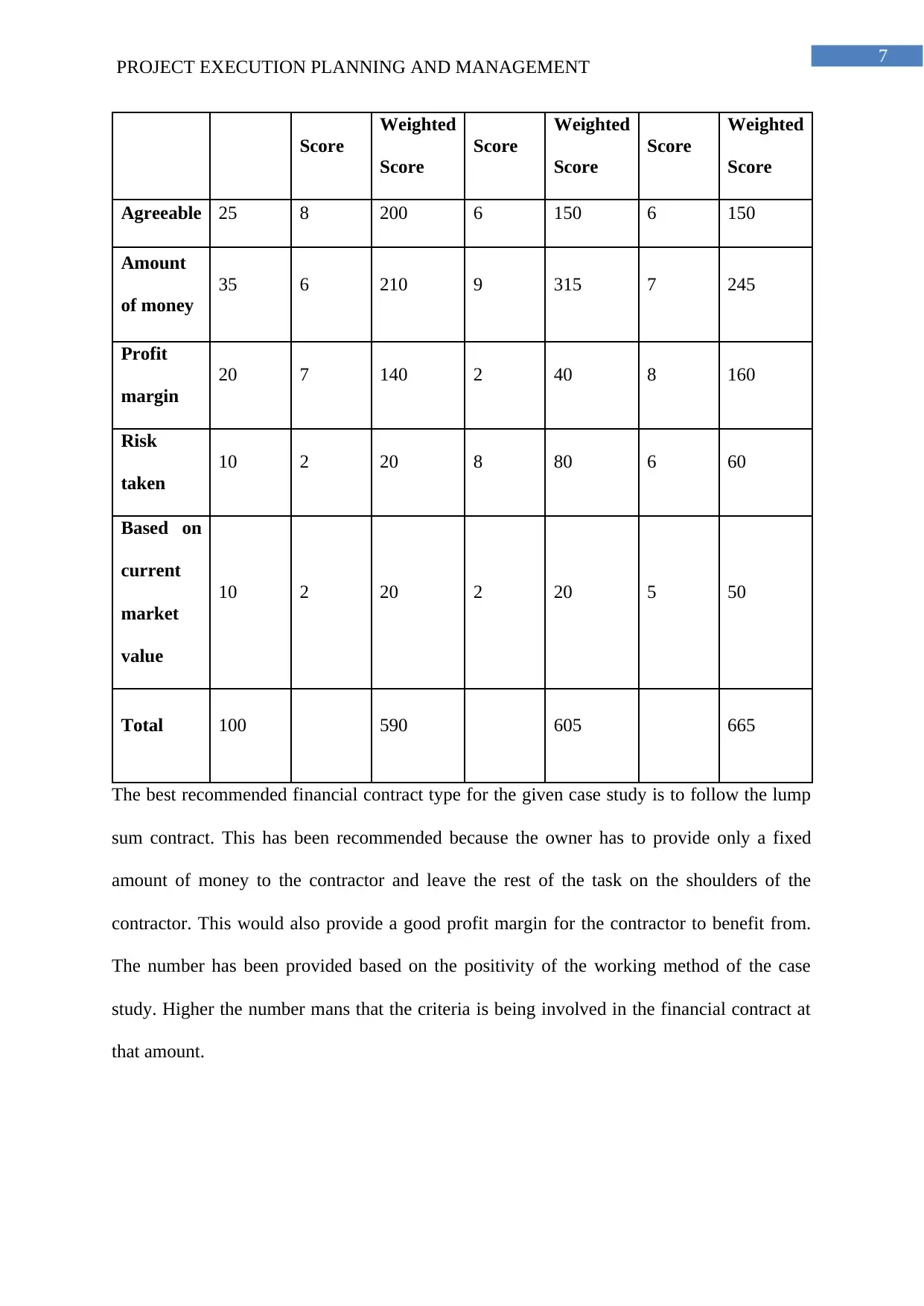
7
PROJECT EXECUTION PLANNING AND MANAGEMENT
Score
Weighted
Score
Score
Weighted
Score
Score
Weighted
Score
Agreeable 25 8 200 6 150 6 150
Amount
of money
35 6 210 9 315 7 245
Profit
margin
20 7 140 2 40 8 160
Risk
taken
10 2 20 8 80 6 60
Based on
current
market
value
10 2 20 2 20 5 50
Total 100 590 605 665
The best recommended financial contract type for the given case study is to follow the lump
sum contract. This has been recommended because the owner has to provide only a fixed
amount of money to the contractor and leave the rest of the task on the shoulders of the
contractor. This would also provide a good profit margin for the contractor to benefit from.
The number has been provided based on the positivity of the working method of the case
study. Higher the number mans that the criteria is being involved in the financial contract at
that amount.
PROJECT EXECUTION PLANNING AND MANAGEMENT
Score
Weighted
Score
Score
Weighted
Score
Score
Weighted
Score
Agreeable 25 8 200 6 150 6 150
Amount
of money
35 6 210 9 315 7 245
Profit
margin
20 7 140 2 40 8 160
Risk
taken
10 2 20 8 80 6 60
Based on
current
market
value
10 2 20 2 20 5 50
Total 100 590 605 665
The best recommended financial contract type for the given case study is to follow the lump
sum contract. This has been recommended because the owner has to provide only a fixed
amount of money to the contractor and leave the rest of the task on the shoulders of the
contractor. This would also provide a good profit margin for the contractor to benefit from.
The number has been provided based on the positivity of the working method of the case
study. Higher the number mans that the criteria is being involved in the financial contract at
that amount.
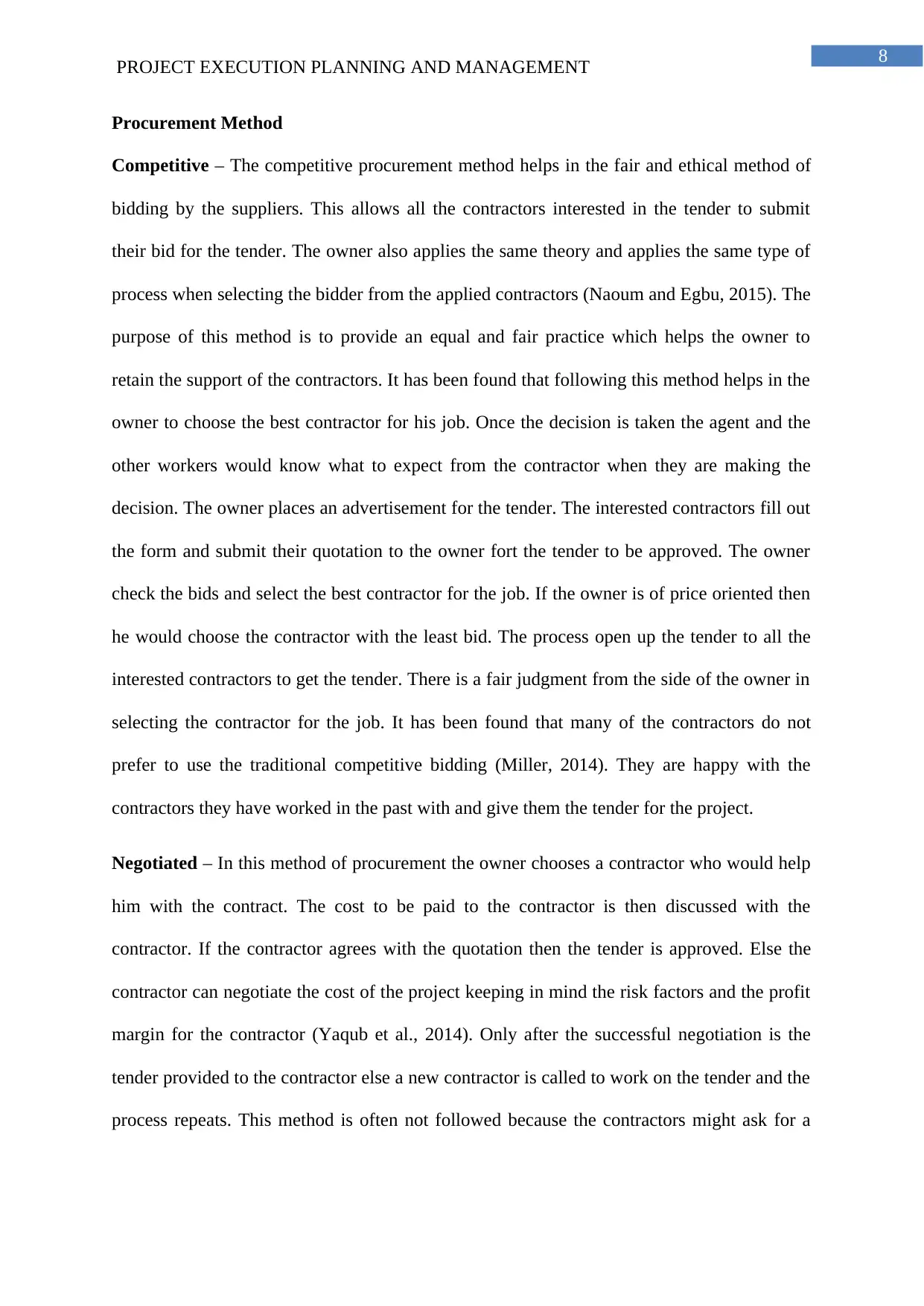
8
PROJECT EXECUTION PLANNING AND MANAGEMENT
Procurement Method
Competitive – The competitive procurement method helps in the fair and ethical method of
bidding by the suppliers. This allows all the contractors interested in the tender to submit
their bid for the tender. The owner also applies the same theory and applies the same type of
process when selecting the bidder from the applied contractors (Naoum and Egbu, 2015). The
purpose of this method is to provide an equal and fair practice which helps the owner to
retain the support of the contractors. It has been found that following this method helps in the
owner to choose the best contractor for his job. Once the decision is taken the agent and the
other workers would know what to expect from the contractor when they are making the
decision. The owner places an advertisement for the tender. The interested contractors fill out
the form and submit their quotation to the owner fort the tender to be approved. The owner
check the bids and select the best contractor for the job. If the owner is of price oriented then
he would choose the contractor with the least bid. The process open up the tender to all the
interested contractors to get the tender. There is a fair judgment from the side of the owner in
selecting the contractor for the job. It has been found that many of the contractors do not
prefer to use the traditional competitive bidding (Miller, 2014). They are happy with the
contractors they have worked in the past with and give them the tender for the project.
Negotiated – In this method of procurement the owner chooses a contractor who would help
him with the contract. The cost to be paid to the contractor is then discussed with the
contractor. If the contractor agrees with the quotation then the tender is approved. Else the
contractor can negotiate the cost of the project keeping in mind the risk factors and the profit
margin for the contractor (Yaqub et al., 2014). Only after the successful negotiation is the
tender provided to the contractor else a new contractor is called to work on the tender and the
process repeats. This method is often not followed because the contractors might ask for a
PROJECT EXECUTION PLANNING AND MANAGEMENT
Procurement Method
Competitive – The competitive procurement method helps in the fair and ethical method of
bidding by the suppliers. This allows all the contractors interested in the tender to submit
their bid for the tender. The owner also applies the same theory and applies the same type of
process when selecting the bidder from the applied contractors (Naoum and Egbu, 2015). The
purpose of this method is to provide an equal and fair practice which helps the owner to
retain the support of the contractors. It has been found that following this method helps in the
owner to choose the best contractor for his job. Once the decision is taken the agent and the
other workers would know what to expect from the contractor when they are making the
decision. The owner places an advertisement for the tender. The interested contractors fill out
the form and submit their quotation to the owner fort the tender to be approved. The owner
check the bids and select the best contractor for the job. If the owner is of price oriented then
he would choose the contractor with the least bid. The process open up the tender to all the
interested contractors to get the tender. There is a fair judgment from the side of the owner in
selecting the contractor for the job. It has been found that many of the contractors do not
prefer to use the traditional competitive bidding (Miller, 2014). They are happy with the
contractors they have worked in the past with and give them the tender for the project.
Negotiated – In this method of procurement the owner chooses a contractor who would help
him with the contract. The cost to be paid to the contractor is then discussed with the
contractor. If the contractor agrees with the quotation then the tender is approved. Else the
contractor can negotiate the cost of the project keeping in mind the risk factors and the profit
margin for the contractor (Yaqub et al., 2014). Only after the successful negotiation is the
tender provided to the contractor else a new contractor is called to work on the tender and the
process repeats. This method is often not followed because the contractors might ask for a
⊘ This is a preview!⊘
Do you want full access?
Subscribe today to unlock all pages.

Trusted by 1+ million students worldwide
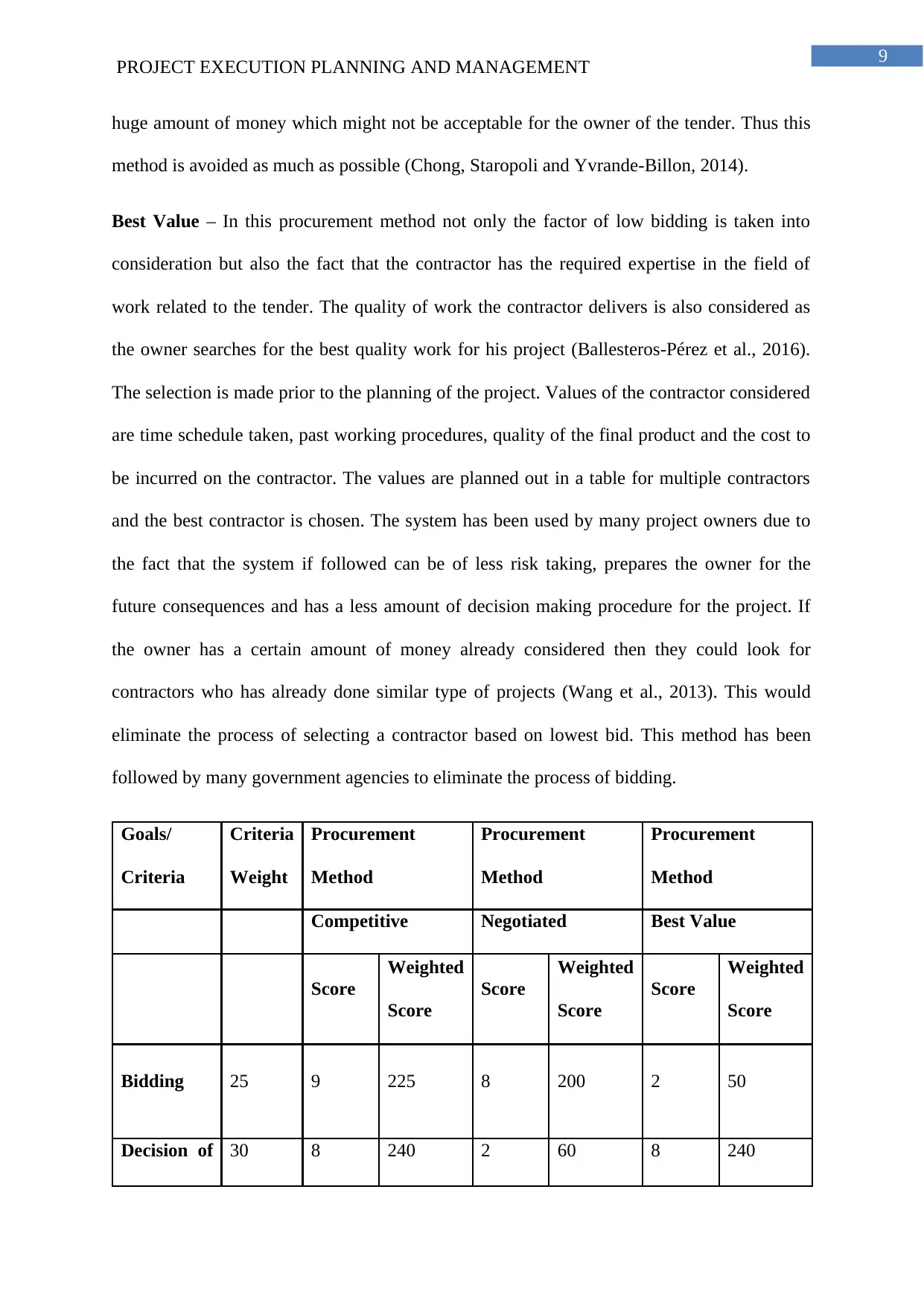
9
PROJECT EXECUTION PLANNING AND MANAGEMENT
huge amount of money which might not be acceptable for the owner of the tender. Thus this
method is avoided as much as possible (Chong, Staropoli and Yvrande-Billon, 2014).
Best Value – In this procurement method not only the factor of low bidding is taken into
consideration but also the fact that the contractor has the required expertise in the field of
work related to the tender. The quality of work the contractor delivers is also considered as
the owner searches for the best quality work for his project (Ballesteros-Pérez et al., 2016).
The selection is made prior to the planning of the project. Values of the contractor considered
are time schedule taken, past working procedures, quality of the final product and the cost to
be incurred on the contractor. The values are planned out in a table for multiple contractors
and the best contractor is chosen. The system has been used by many project owners due to
the fact that the system if followed can be of less risk taking, prepares the owner for the
future consequences and has a less amount of decision making procedure for the project. If
the owner has a certain amount of money already considered then they could look for
contractors who has already done similar type of projects (Wang et al., 2013). This would
eliminate the process of selecting a contractor based on lowest bid. This method has been
followed by many government agencies to eliminate the process of bidding.
Goals/
Criteria
Criteria
Weight
Procurement
Method
Procurement
Method
Procurement
Method
Competitive Negotiated Best Value
Score
Weighted
Score
Score
Weighted
Score
Score
Weighted
Score
Bidding 25 9 225 8 200 2 50
Decision of 30 8 240 2 60 8 240
PROJECT EXECUTION PLANNING AND MANAGEMENT
huge amount of money which might not be acceptable for the owner of the tender. Thus this
method is avoided as much as possible (Chong, Staropoli and Yvrande-Billon, 2014).
Best Value – In this procurement method not only the factor of low bidding is taken into
consideration but also the fact that the contractor has the required expertise in the field of
work related to the tender. The quality of work the contractor delivers is also considered as
the owner searches for the best quality work for his project (Ballesteros-Pérez et al., 2016).
The selection is made prior to the planning of the project. Values of the contractor considered
are time schedule taken, past working procedures, quality of the final product and the cost to
be incurred on the contractor. The values are planned out in a table for multiple contractors
and the best contractor is chosen. The system has been used by many project owners due to
the fact that the system if followed can be of less risk taking, prepares the owner for the
future consequences and has a less amount of decision making procedure for the project. If
the owner has a certain amount of money already considered then they could look for
contractors who has already done similar type of projects (Wang et al., 2013). This would
eliminate the process of selecting a contractor based on lowest bid. This method has been
followed by many government agencies to eliminate the process of bidding.
Goals/
Criteria
Criteria
Weight
Procurement
Method
Procurement
Method
Procurement
Method
Competitive Negotiated Best Value
Score
Weighted
Score
Score
Weighted
Score
Score
Weighted
Score
Bidding 25 9 225 8 200 2 50
Decision of 30 8 240 2 60 8 240
Paraphrase This Document
Need a fresh take? Get an instant paraphrase of this document with our AI Paraphraser
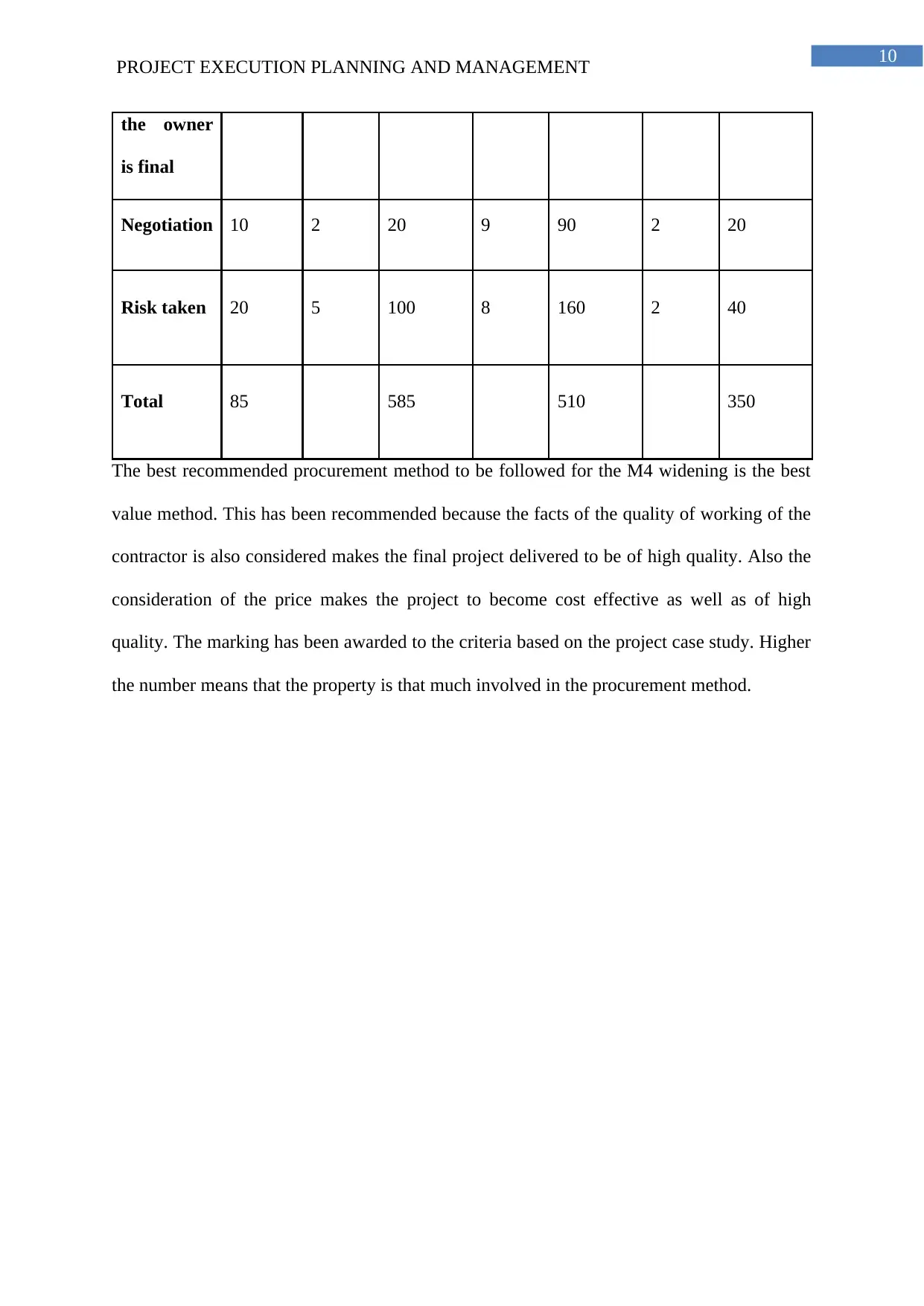
10
PROJECT EXECUTION PLANNING AND MANAGEMENT
the owner
is final
Negotiation 10 2 20 9 90 2 20
Risk taken 20 5 100 8 160 2 40
Total 85 585 510 350
The best recommended procurement method to be followed for the M4 widening is the best
value method. This has been recommended because the facts of the quality of working of the
contractor is also considered makes the final project delivered to be of high quality. Also the
consideration of the price makes the project to become cost effective as well as of high
quality. The marking has been awarded to the criteria based on the project case study. Higher
the number means that the property is that much involved in the procurement method.
PROJECT EXECUTION PLANNING AND MANAGEMENT
the owner
is final
Negotiation 10 2 20 9 90 2 20
Risk taken 20 5 100 8 160 2 40
Total 85 585 510 350
The best recommended procurement method to be followed for the M4 widening is the best
value method. This has been recommended because the facts of the quality of working of the
contractor is also considered makes the final project delivered to be of high quality. Also the
consideration of the price makes the project to become cost effective as well as of high
quality. The marking has been awarded to the criteria based on the project case study. Higher
the number means that the property is that much involved in the procurement method.
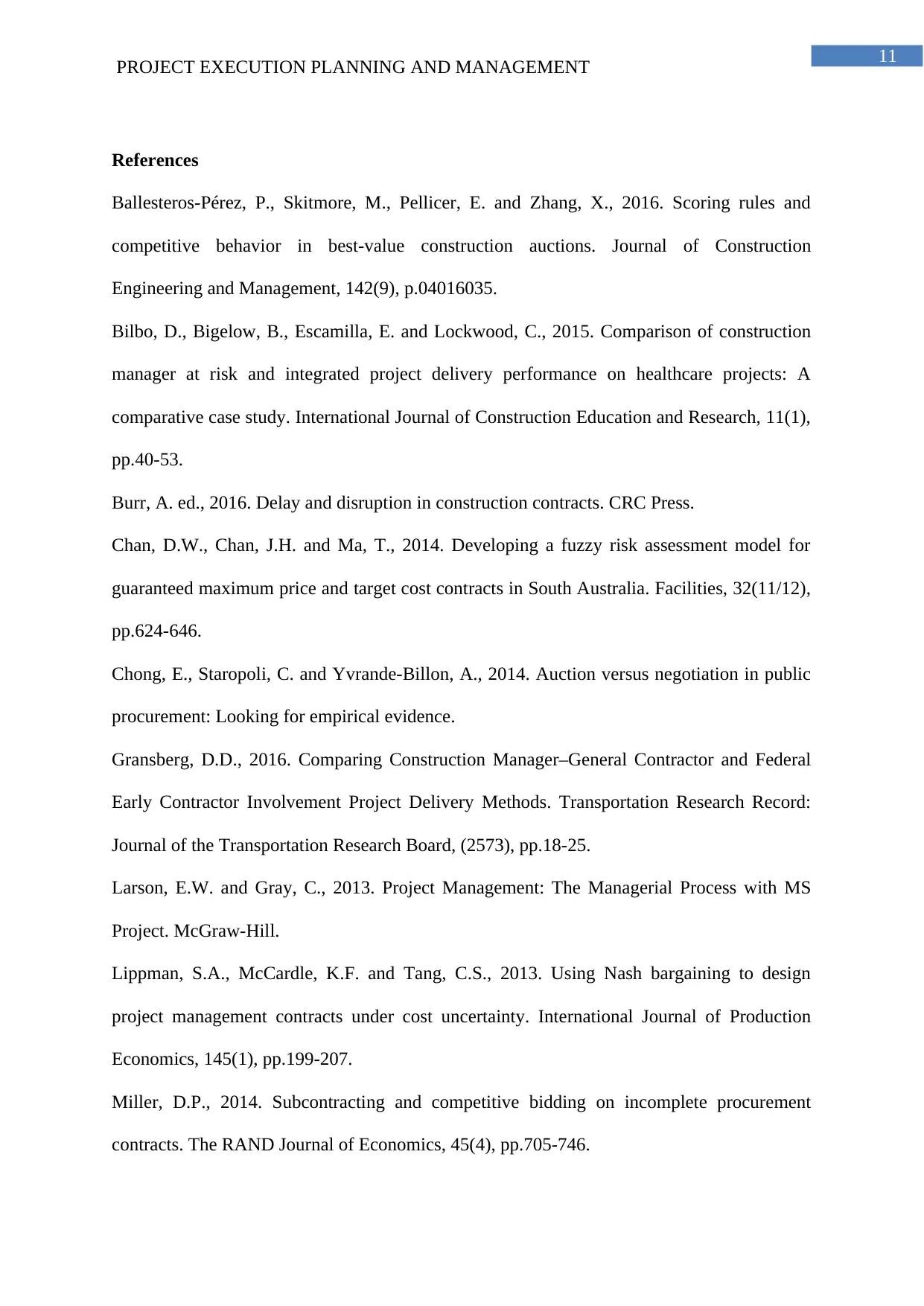
11
PROJECT EXECUTION PLANNING AND MANAGEMENT
References
Ballesteros-Pérez, P., Skitmore, M., Pellicer, E. and Zhang, X., 2016. Scoring rules and
competitive behavior in best-value construction auctions. Journal of Construction
Engineering and Management, 142(9), p.04016035.
Bilbo, D., Bigelow, B., Escamilla, E. and Lockwood, C., 2015. Comparison of construction
manager at risk and integrated project delivery performance on healthcare projects: A
comparative case study. International Journal of Construction Education and Research, 11(1),
pp.40-53.
Burr, A. ed., 2016. Delay and disruption in construction contracts. CRC Press.
Chan, D.W., Chan, J.H. and Ma, T., 2014. Developing a fuzzy risk assessment model for
guaranteed maximum price and target cost contracts in South Australia. Facilities, 32(11/12),
pp.624-646.
Chong, E., Staropoli, C. and Yvrande-Billon, A., 2014. Auction versus negotiation in public
procurement: Looking for empirical evidence.
Gransberg, D.D., 2016. Comparing Construction Manager–General Contractor and Federal
Early Contractor Involvement Project Delivery Methods. Transportation Research Record:
Journal of the Transportation Research Board, (2573), pp.18-25.
Larson, E.W. and Gray, C., 2013. Project Management: The Managerial Process with MS
Project. McGraw-Hill.
Lippman, S.A., McCardle, K.F. and Tang, C.S., 2013. Using Nash bargaining to design
project management contracts under cost uncertainty. International Journal of Production
Economics, 145(1), pp.199-207.
Miller, D.P., 2014. Subcontracting and competitive bidding on incomplete procurement
contracts. The RAND Journal of Economics, 45(4), pp.705-746.
PROJECT EXECUTION PLANNING AND MANAGEMENT
References
Ballesteros-Pérez, P., Skitmore, M., Pellicer, E. and Zhang, X., 2016. Scoring rules and
competitive behavior in best-value construction auctions. Journal of Construction
Engineering and Management, 142(9), p.04016035.
Bilbo, D., Bigelow, B., Escamilla, E. and Lockwood, C., 2015. Comparison of construction
manager at risk and integrated project delivery performance on healthcare projects: A
comparative case study. International Journal of Construction Education and Research, 11(1),
pp.40-53.
Burr, A. ed., 2016. Delay and disruption in construction contracts. CRC Press.
Chan, D.W., Chan, J.H. and Ma, T., 2014. Developing a fuzzy risk assessment model for
guaranteed maximum price and target cost contracts in South Australia. Facilities, 32(11/12),
pp.624-646.
Chong, E., Staropoli, C. and Yvrande-Billon, A., 2014. Auction versus negotiation in public
procurement: Looking for empirical evidence.
Gransberg, D.D., 2016. Comparing Construction Manager–General Contractor and Federal
Early Contractor Involvement Project Delivery Methods. Transportation Research Record:
Journal of the Transportation Research Board, (2573), pp.18-25.
Larson, E.W. and Gray, C., 2013. Project Management: The Managerial Process with MS
Project. McGraw-Hill.
Lippman, S.A., McCardle, K.F. and Tang, C.S., 2013. Using Nash bargaining to design
project management contracts under cost uncertainty. International Journal of Production
Economics, 145(1), pp.199-207.
Miller, D.P., 2014. Subcontracting and competitive bidding on incomplete procurement
contracts. The RAND Journal of Economics, 45(4), pp.705-746.
⊘ This is a preview!⊘
Do you want full access?
Subscribe today to unlock all pages.

Trusted by 1+ million students worldwide
1 out of 13
Related Documents
Your All-in-One AI-Powered Toolkit for Academic Success.
+13062052269
info@desklib.com
Available 24*7 on WhatsApp / Email
![[object Object]](/_next/static/media/star-bottom.7253800d.svg)
Unlock your academic potential
Copyright © 2020–2025 A2Z Services. All Rights Reserved. Developed and managed by ZUCOL.



